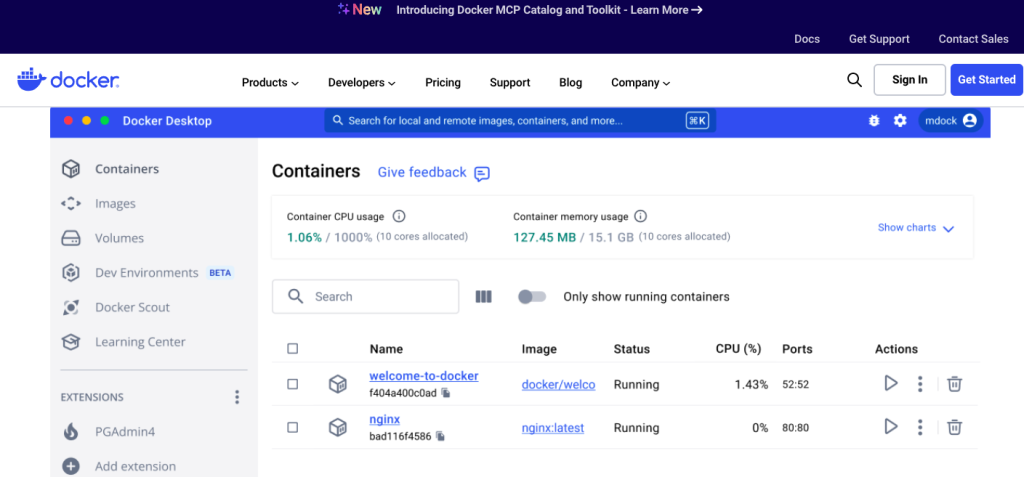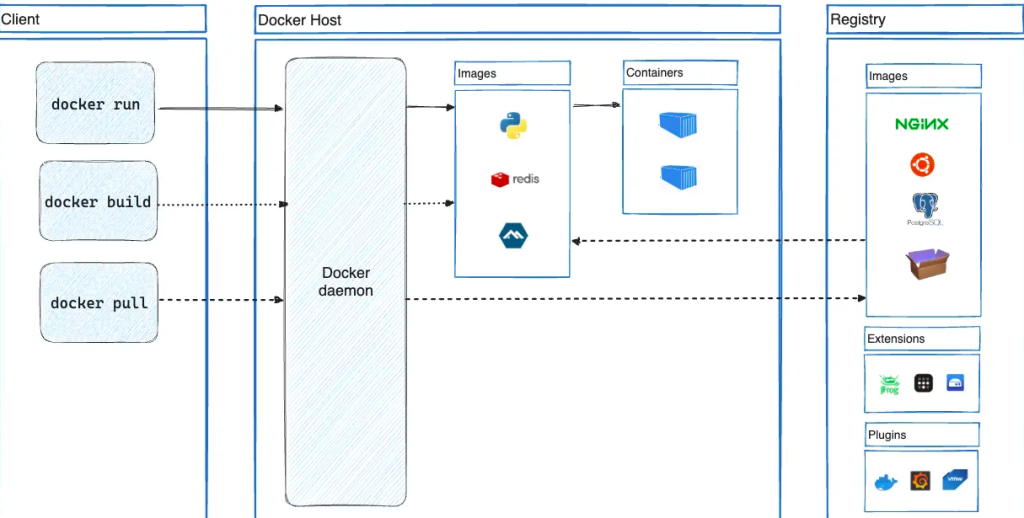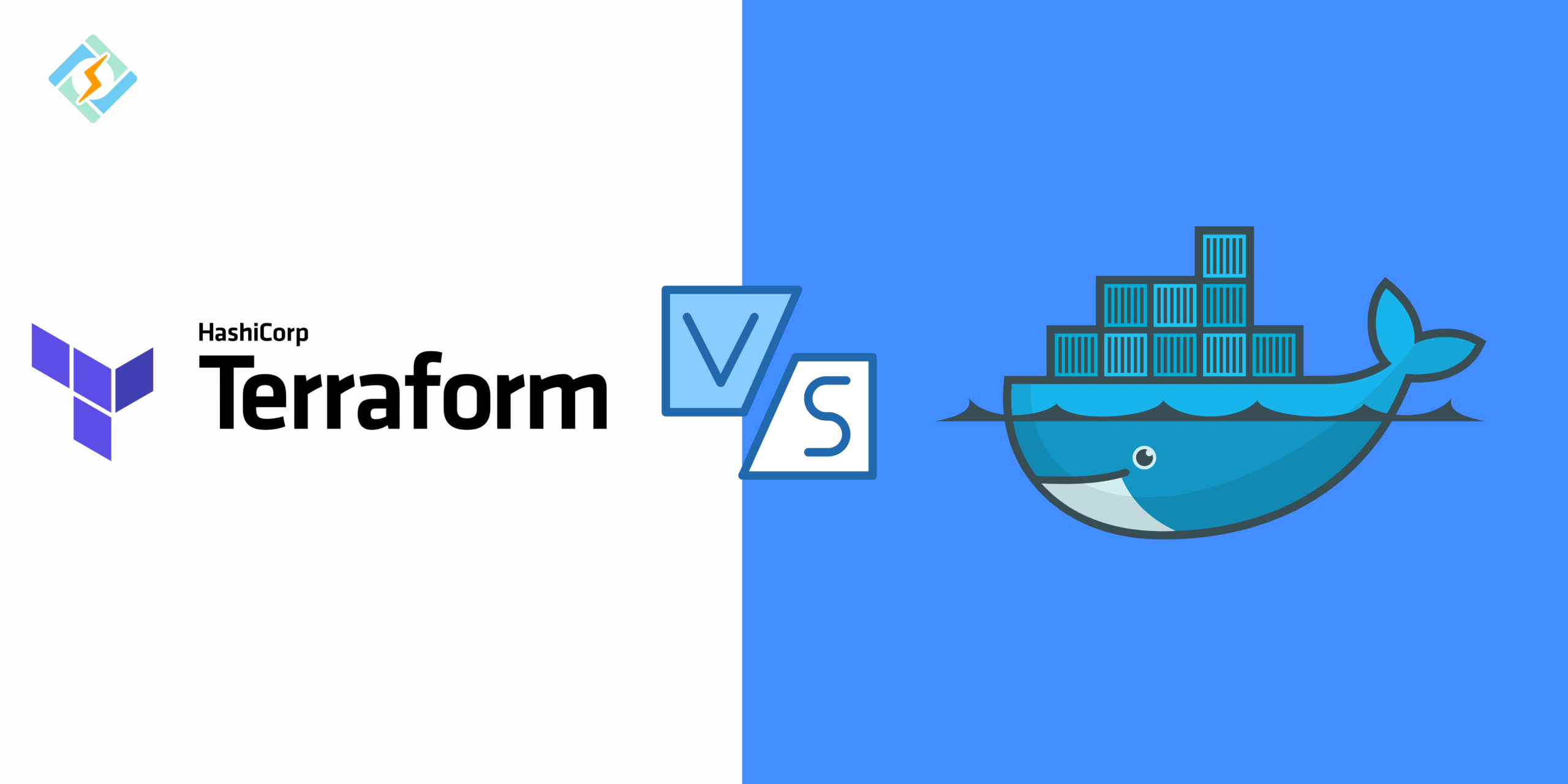Docker vs Terraform are the building blocks for modern software delivery.
In today’s evolving DevOps environment, you’re expected to deploy faster, smartly manage your infrastructure to scale without breaking things.
While both are incredibly powerful, they serve very different purposes. While Terraform focuses on provisioning and managing infrastructure across cloud providers, Docker packages and runs applications in lightweight containers.
Whether you’re a DevOps engineer, cloud architect, or developer, understanding the strengths and weaknesses is crucial for you and your skillset.
Now, this article will help you clear the confusion about which one to use. We’re breaking down Docker vs Terraform in plain terms, comparing features, use cases, and more!
Let’s Learn Along!
Get exclusive access to all things tech-savvy, and be the first to receive
the latest updates directly in your inbox.
What Is Docker?

Docker is an open-source platform designed to automate the deployment, scaling, and management of applications using containerization.
It works smoothly with your favorite development tools like VS Code, CircleCI, and GitHub. Plus, Docker Build Cloud speeds up build times, making your workflow better and uninterrupted.
Docker containers bundle your app along with everything it needs (like libraries, frameworks, and settings) into a handy package.
Interesting how it works. Developers write code on their machines and share it with teammates through Docker containers. They use Docker to upload their applications to a test environment where they conduct both automated and manual tests.
If bugs are found, they can be rectified in the development environment and then redeployed to the test environment for further testing and validation. Once testing is finished, delivering the fix to the customer is easy; push the updated image to the production environment.
What is Terraform?

Terraform is an open-source Infrastructure as code tool that’s developed by HashiCorp.
Because it makes it easier to set up, configure, and manage your infrastructure. You can write your infrastructure resources in code, which helps keep deployments consistent and dependable. It’s flexible and robust, perfect for anything from small projects to big companies across various cloud platforms, simplifying infrastructure management.
Today, it has revolutionized infrastructure management for many reasons, including its declarative syntax, multi-cloud support, and version control features. With a declarative approach, you define the desired state of your infrastructure, and Terraform manages the resources to achieve that.
It can support multiple cloud providers like AWS, Azure, and GCP, allowing for consistent management across different environments. Additionally, Terraform configurations can be version-controlled, enabling change tracking, team collaboration, and easy rollbacks.

Docker vs Terraform: Core Differences Explained
| Feature | Docker | Terraform |
| Purpose | Containerization | Infrastructure provisioning |
| Language | Dockerfile/ YAML | HCL ( HashiCorp Configuration Language) |
| Use Case | Deploying applications | Building cloud infrastructure |
| Learning Curve | Moderate | Steeper |
| State Management | Not required | Required (tfstate file) |
| Popular Tools | Docker Compose, Kubernetes | AWS, GCP, Azure modules. |
Let’s explain a few aspects in detail so you get a clearer understanding:
Area of focus
Terraform is about managing and providing infrastructure, defining what is needed, like VMs, databases, and networks for your application.
Docker is focused on containerization and deploying applications, packaging them with their dependencies into containers for consistent performance across different environments.
Abstraction Level
Terraform functions at a more abstract level. It handles infrastructure resources as building blocks, enabling you to specify load balancers, databases, and virtual machines.
Docker operates at a lower level, in comparison. Its main goal is to enable consistent operation of application code and its dependencies in a variety of settings by encapsulating them in portable containers.
Their Approaches to Management
The method used by Terraform is declarative. In Terraform configuration files, users specify the ideal condition of the infrastructure (such as the quantity of virtual machines and storage capacity). After that, Terraform automatically organizes and carries out the tasks required to reach that state. Users no longer need to write intricate scripts outlining each process, which streamlines infrastructure administration.
Docker leverages an imperative methodology. Containerized apps are built and deployed by users by defining a series of commands. Dockerfiles are used to outline the procedures for creating container images, such as setting up the application environment and installing dependencies. In contrast to Terraform’s declarative design, this method necessitates more manual settings while providing flexibility.

State Management
Terraform vs Docker keeps its own record of the infrastructure it oversees. This state data encompasses information about the resources that have been provisioned along with their configurations. It enables Terraform to monitor modifications and identify the most effective approach to reach the desired state.
Docker vs Terraform lacks inherent state management for applications running in containers. Although Docker containers are designed to be stateless, managing application data within these containers frequently necessitates the use of additional tools such as container orchestration platforms (e.g., Kubernetes) for applications requiring statefulness.
Security
Terraform vs Docker emphasizes infrastructure security by allowing users to set security parameters for resources, including access control lists (ACLs) and security groups. Nonetheless, it does not directly handle container security issues.
Docker vs Terraform offers basic security features for container images, such as user isolation and resource limitations. For thorough container security, however, it is advisable to integrate with specialized container security tools.
Scalability
While Terraform vs Docker is proficient at provisioning infrastructure on a large scale, scaling the infrastructure itself generally requires extra scripting or integration with tools from cloud providers.
Docker vs Kubernetes containers are naturally scalable. They can be rapidly created or removed according to demand, making them perfect for applications with varying resource needs. Utilizing Docker containers in conjunction with orchestration platforms like Kubernetes further improves container scalability by overseeing deployments and scaling across multiple servers.
Learning Curve
Terraform vs Docker presents a learning curve related to its configuration language and the comprehension of infrastructure concepts.
Docker vs Terraform might be simpler for developers who are already acquainted with containerization principles. However, constructing intricate multi-container applications can introduce a more significant learning curve.
Can Docker and Terraform Be Used Together?
To your surprise, YES! The two tools aren’t mutually exclusive but can in fact complement each other in multiple scenarios. Using Terraform and Docker together enhances application deployment by combining their strengths. This duo allows developers to automate and manage infrastructure effectively.
A very common application of this combination is in creating a CI/CD pipeline. Terraform creates the AWS EC2 instance, for example, and further manages infrastructure setup across various environments, while Docker automates the deployment of containers.
Terraform provisions the necessary infrastructure, like virtual machines, to run Docker containers in the cloud. It can also build Docker images by executing the Dockerfile through the Terraform Docker provider.
This integration simplifies infrastructure management and application deployment, ensuring consistency and efficiency across different environments. Moreover, it automates the entire deployment process, from setting up infrastructure to launching applications.
Docker Should Be Your Go-to When:
Deploying microservices: Microservices split applications into smaller, standalone services. Docker containers are great for packaging and deploying these services, allowing them to work and grow independently.
Automating builds and deployments: Docker supports consistent and automated application builds and deployments through CI/CD pipelines, speeding up development and making deployments smoother.
Updating old applications: Docker can be used to package old applications, letting them take advantage of the flexibility and scalability of containers.
Ensuring applications work the same everywhere: Docker containers ensure that applications behave consistently, no matter where they run. Each container includes the application code and all necessary components, so there are no compatibility problems.
Terraform Should Be Your Go-To When:
Setting up a complex web application: Terraform can help set up all the resources your web application needs, like web servers, databases, load balancers, and security groups, across various cloud services.
Managing resources in multiple cloud services: If you need to handle resources like virtual machines, databases, and networks in AWS, Azure, or GCP, Terraform’s support for multiple clouds and automation features make it a great option.
Keeping infrastructure the same across different settings: Terraform is perfect for making sure your development, testing, and production environments have the same setup. Its version-controlled settings help ensure that deployments are consistent and repeatable.
Making infrastructure changes easy: Terraform lets you outline changes in its configuration files. Once you do this, you can quickly apply those changes to your cloud resources, making updates easier.
Conclusion: Which One Is Right for Your DevOps Workflow?
This guide explained the two powerful DevOps tools in detail. In 2025, DevOps will focus on picking the right tools for specific tasks instead of relying on just one perfect tool. Terraform vs Docker serve different purposes: Terraform is great for automating infrastructure, while Docker makes app deployment easier. Understand their strengths, use them wisely, and feel free to mix them for an effective DevOps process.
1. What’s the main difference between Docker vs Terraform?
Docker compose vs Terraform is all about packaging and running apps in containers, while Terraform is for setting up and managing infrastructure using code (IaC).
2: Can you use Docker and Terraform together?
Yep! Terraform vs Docker can set up the infrastructure (like servers and databases), and Docker can run containerized apps on that infrastructure, making them a great DevOps duo.
3. Is Terraform harder to learn than Docker?
Usually, yes. Docker vs Terraform tends to be easier for developers because it has simpler syntax and gives quick feedback, while Terraform needs you to grasp cloud concepts, HCL syntax, and how to manage states.
4: Does Terraform take over for Kubernetes or Docker?
Nope! Terraform is for managing infrastructure setup. Docker deals with containers, and Kubernetes helps coordinate those containers. Each one has its job in the DevOps process.
5. Do I need Kubernetes if I’m using Docker and Terraform?
Only if you want to manage a bunch of containers together. Docker is for single containers, and Kubernetes is for clusters. Terraform can also help set up Kubernetes clusters.
6: Is Docker safe for production environments?
Yes, but only if you set it up right. Use small base images, do container scans, apply runtime restrictions, and keep workloads separate for good security.
7: What cloud platforms will Terraform work with in 2025?
Terraform will support all the big cloud providers like AWS, Azure, GCP, Oracle Cloud, DigitalOcean, Alibaba Cloud, and more, given its flexible provider system.



